How to Remove Vertical Blinds | It’s Easier Than You Think
If there is one thing that plagues renters more than anything else, I think it might be vertical blinds! Gah – not only are they downright ugly, but they are notoriously prone to damage, constantly fall down, and are seemingly installed in every single rental property. But thankfully, you don’t have to deal with them…even if you are a renter! Today, I want to show you how to remove vertical blinds so you can put up something nicer instead (or just save your sanity!)
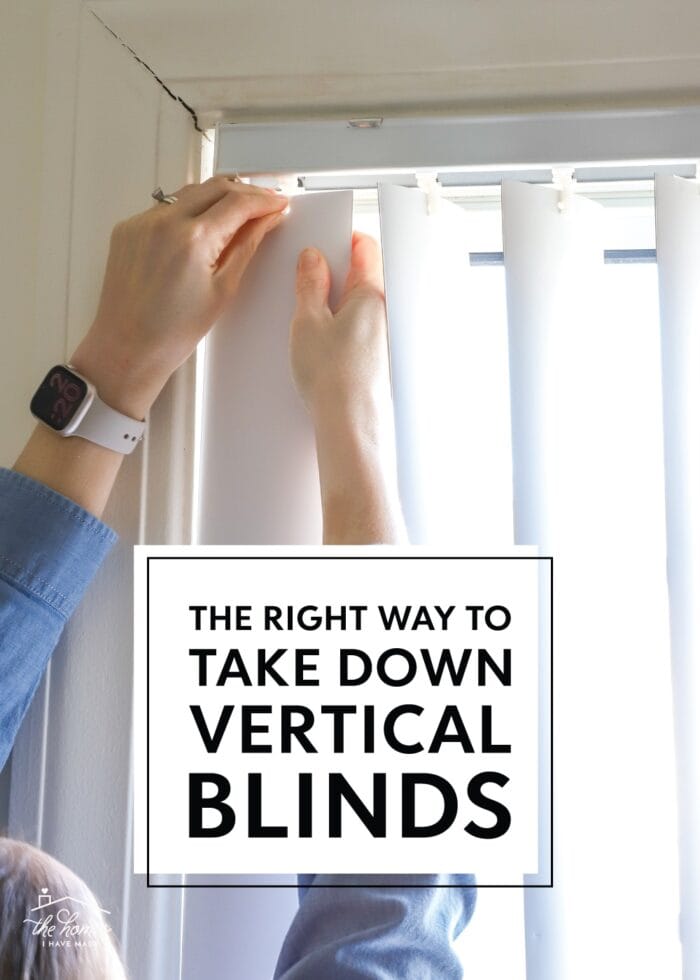
The “Why” Behind Vertical Blinds
We have now lived in 9 different rental properties…5 of them have/had vertical blinds on every single window and one had them installed on the sliding glass door only. Only three didn’t have a single vertical blind to deal with in the entire home.
The point I’m making here is that…at least in rental properties…you are more likely to encounter vertical blinds than not. Most especially if you are living in a commercially-managed property (such as military base housing) compared to a privately owned home.
While I don’t have concrete evidence as to why, I strongly suspect that vertical blind are the rental window “standard” because they are cheap and easy to install (and fix) compared to other window treatments such as horizontal blinds, shades, curtains, etc. And since most rental properties need to provide some sort of window coverings for their tenants, vertical blinds have become the all-too-common solution.
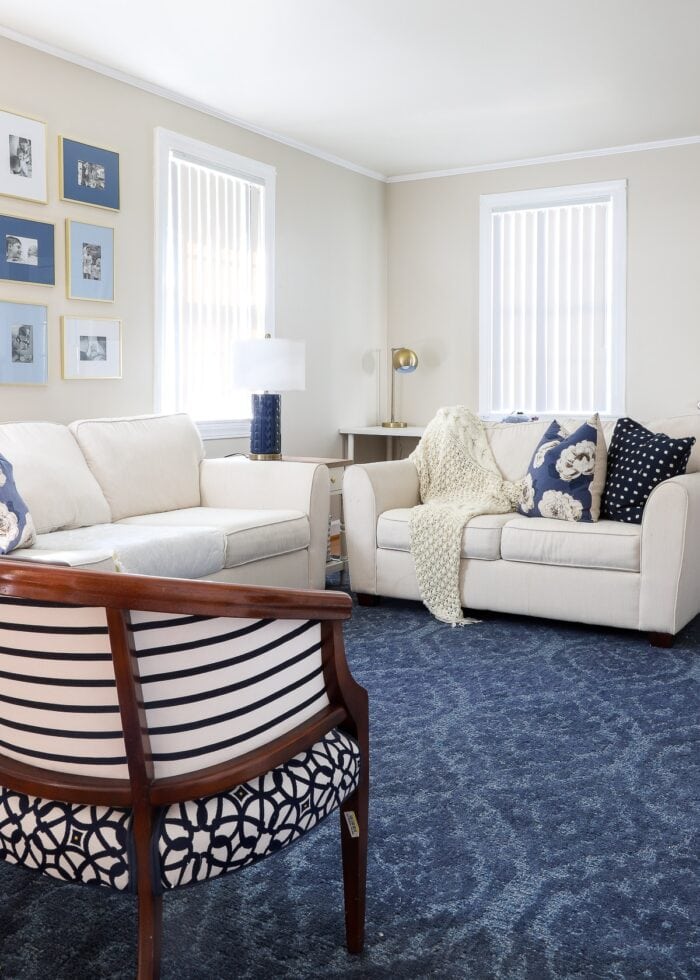
The “Problem” With Vertical Blinds
When it comes to blocking light and providing privacy, yes…vertical blinds certainly get the job done; and they are definitely better to have on your windows compared to nothing at all (especially when you are first moving in and haven’t hung curtains yet!) But they are also far from the ideal window covering solution!
They Are Not Blackout
Because of the space between each vertical slat, as well as on the sides of the windows, it is practically impossible to get a full “blackout” of light coming through the window. So while vertical blinds do provide 100% privacy and will darken a room, they still allow in a fair amount of light. This can be an issue for babies or anyone who needs complete darkness to sleep.
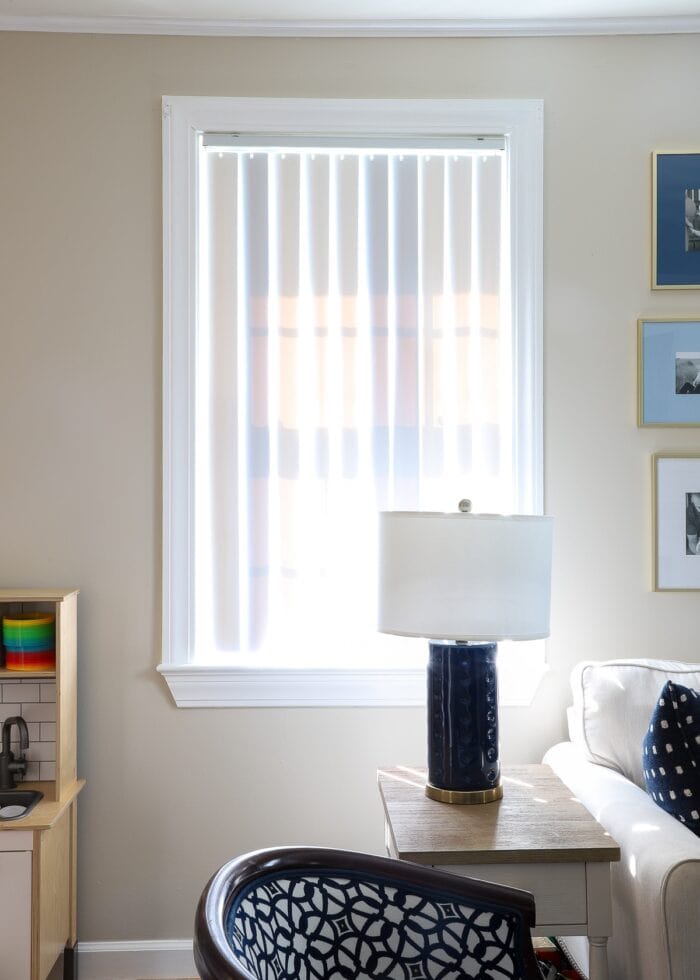
They Break
Ugh – whether you have kids or not (but especially if you have kids), vertical blinds break SOOOO easily just from regular daily use. The twisting rod mechanism (that opens and closes the blinds) is especially sensitive. It’s also not particularly easy to fix; so if it does break, the entire rail often needs replacing (which is usually a maintenance call!)
But beyond the head rail, the vertical slats themselves are a nuisance. They fall out of the clips quite easily, and the heat/light from the sun can often wear out the slit that holds up the slat. As a result, the blinds fall and/or need replacing constantly.
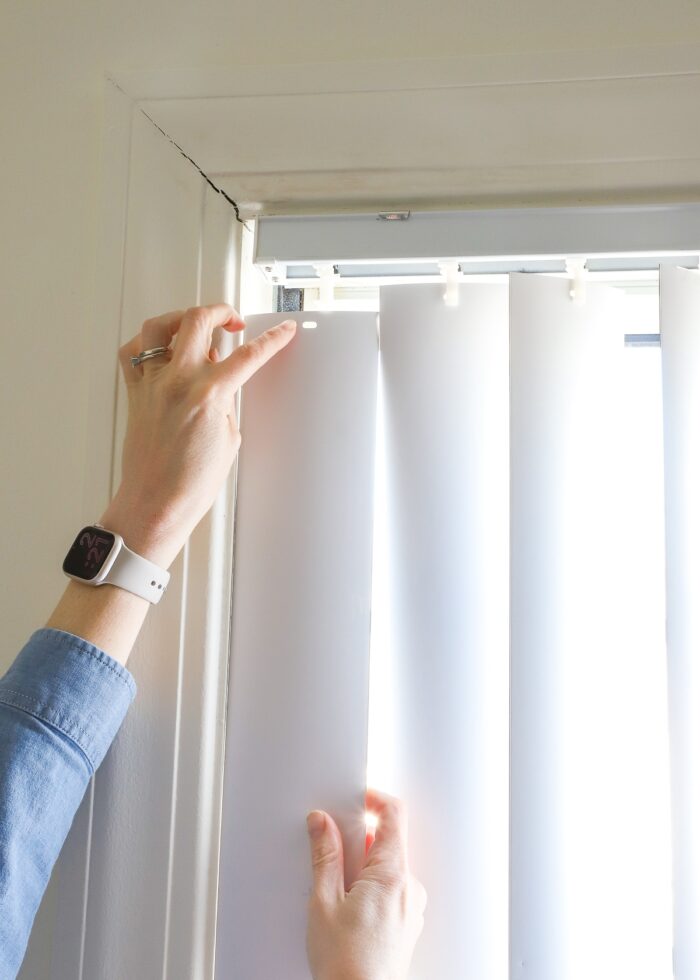
They’re Messy
In general, vertical blinds look messier compared to their horizontal counterparts. It’s common for them to twist un-uniformly; they can easily get stuck on diagonal in the window frame or with other blinds; and the sun/heat can cause them to warp or bend…all resulting in an eye soar from any angle.
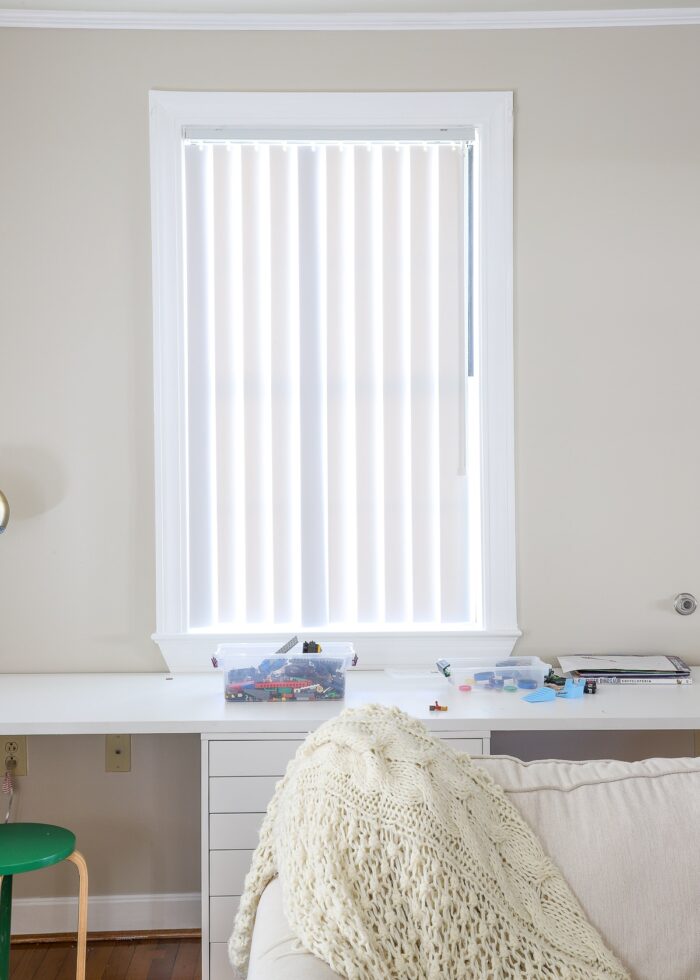
They’re Ugly
Okay – let’s just put this out there. Vertical blinds are ugly and cheap-looking. So yes, they perform a function in our homes; but they don’t do anything aesthetically. While window treatments add style, texture, and comfort to a space, the white, plastic-y blob created by vertical blinds conveys a cheap, utilitarian, temporary aesthetic to a room.

How to Remove Vertical Blinds
Whether you need a better light-blocking solution, are tired of them breaking, or simply hate the way they look, you don’t have to “put up” with your vertical blinds. They are really easy to take down (like…REALLY easy). Let me show you!
Video Tutorial
If you’d rather watch how to removal vertical blinds, here is the entire tutorial on video. (Video not loading for you? You can watch it HERE).
Step 1 – Remove Vertical Slats from Plastic Spring Clips (Vane Carriers)
Start by un-hooking each and every blind from its individual plastic clasp. Do this by lifting the very top of the blind slightly up and toward you until it un-hooks.
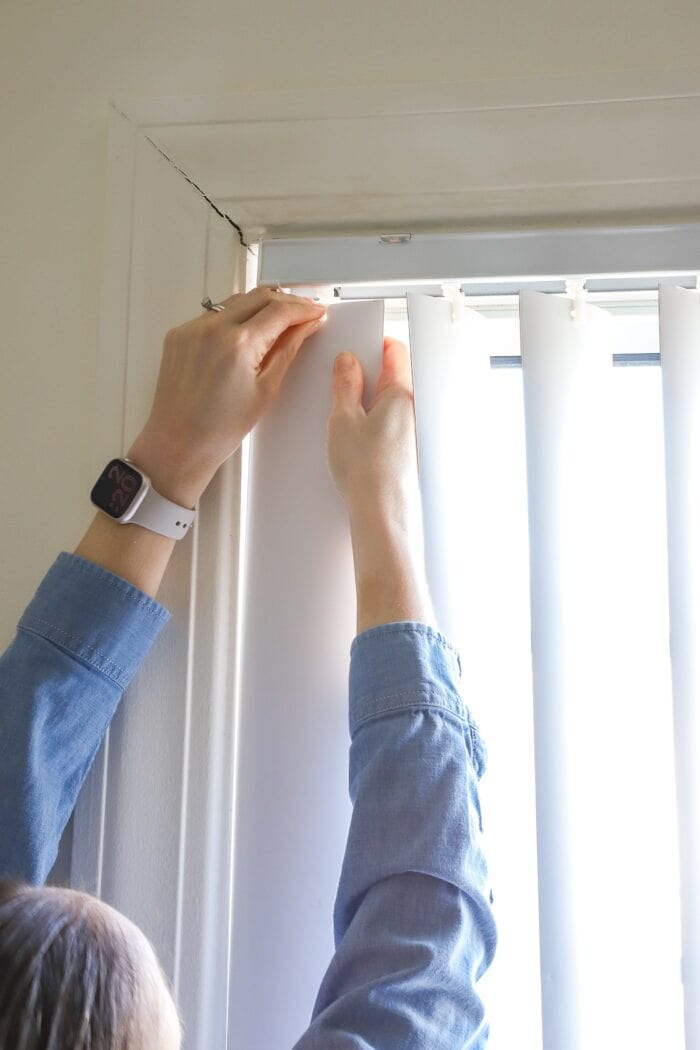
Get a ladder or stool so that you are eye-level with the plastic clips and can see what you are doing. It may seem tricky at first; but once you get the hang of it, the individual blinds come out quite easily.
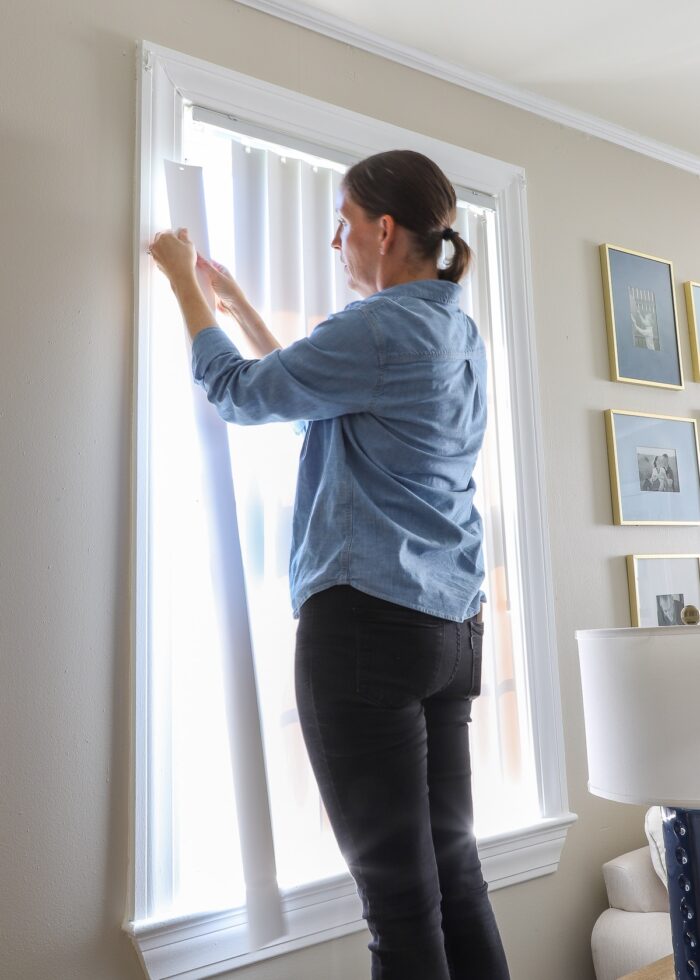
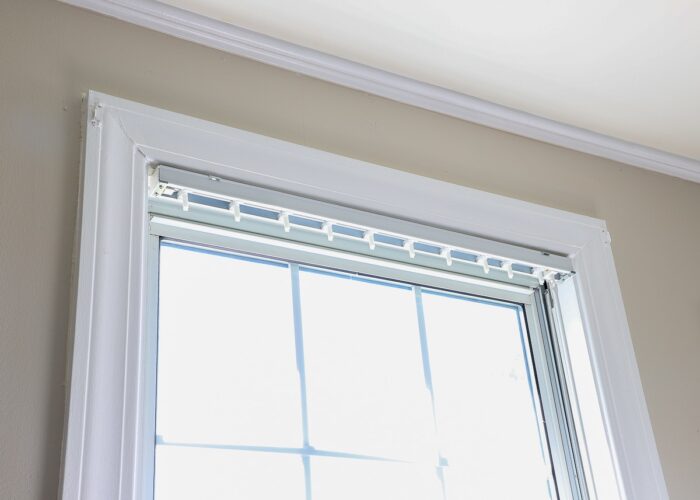
Step 2 – Remove Headrail from Brackets
Once the blinds are down, you will next remove the entire headrail from the metal brackets (which are what hold the entire unit to the window).
To do this, pop the back of the brackets off the headrail first (the sides closest to the window). Once the back of the headrail is released, you’ll be able to pull the rail free from the front of the brackets as well.
Depending on how long the headrail has been installed, it can be pretty tight inside the clasps. You might need a flathead screwdriver to pry the rail from the bracket or find someone with really strong grip strength to get the rail out for you.
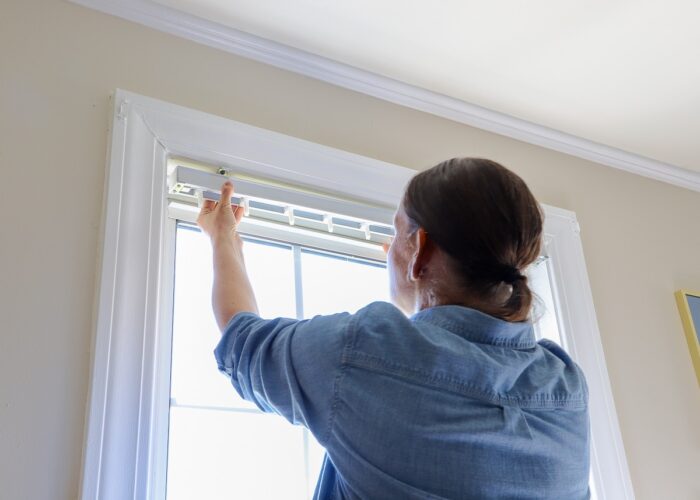
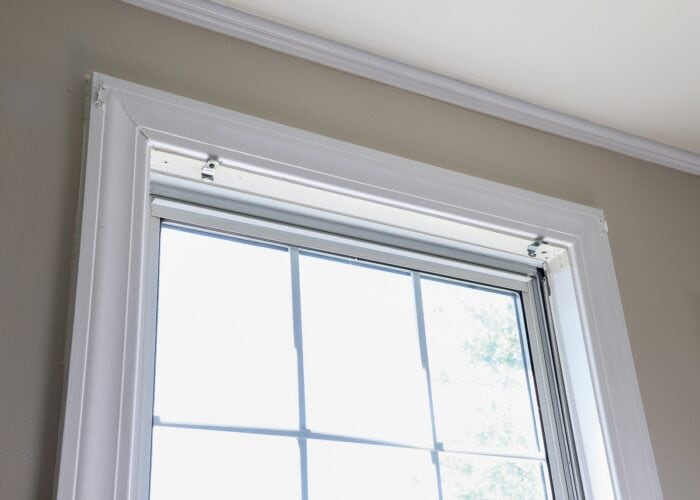
Step 3 – Remove Brackets from Window
With the blind rail down, all that should be left are 2 (or more) metal brackets still screwed into the top of the window frame. You can either leave these in place (if you’re not going to install something different) or simply unscrew them with a screwdriver.
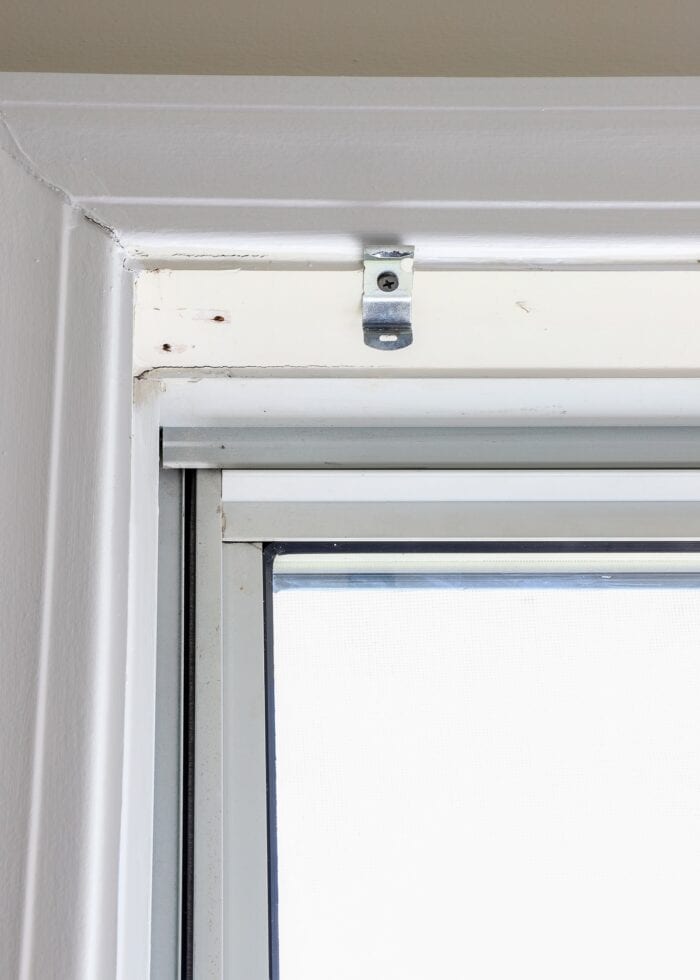
I personally recommend taking the hardware down because they can still be a visual distraction at the top of every window.
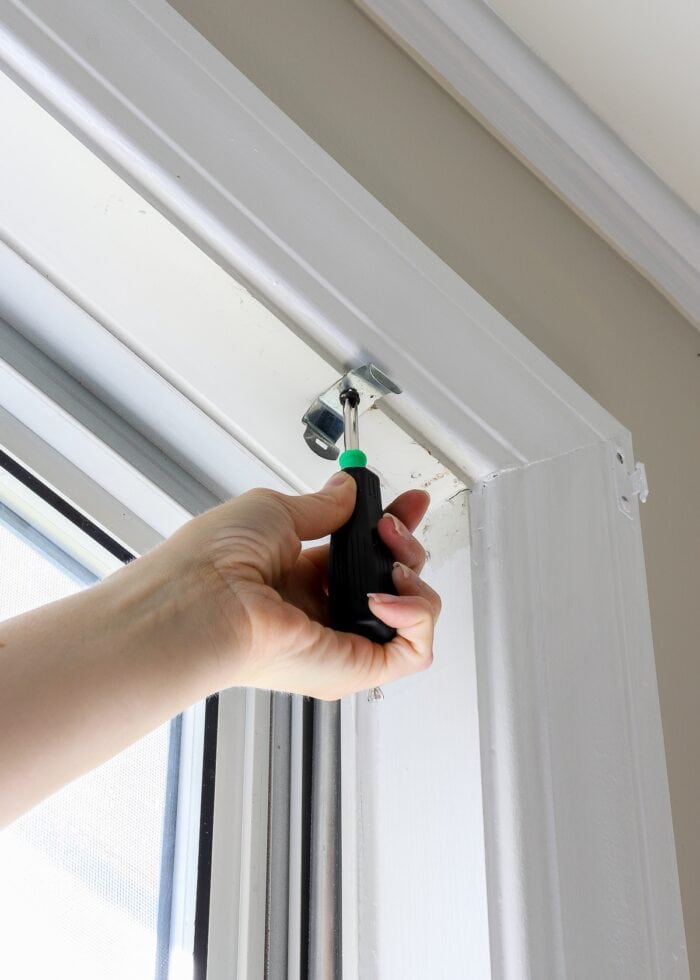
How to Safely Store Vertical Blinds
Instead of un-clipping the individual blinds as I outline above, you might be tempted to simply take the headrail down with all the blinds still attached and store the entire structure as a unit.
Been there, done that, and I can tell you: don’t do it!
Not only does that approach take up WAY more storage space than necessary (plus you have to figure out where/how to hang it), but this can also damage the blinds, headrail, or both.
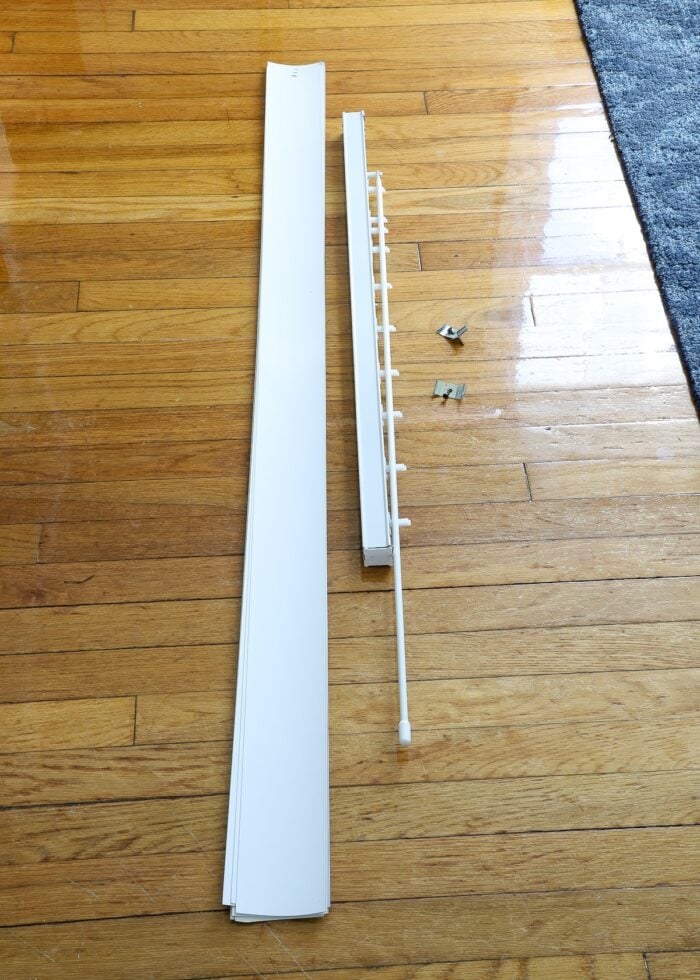
The blinds are easy to take off, and fully disassembling the slats from the rails will allow you to store everything more compactly (and safely), should you need to put the blinds back up before moving out.
- Stack all the vertical blinds for a single window on top of each other, lining up all the ends.
- Manipulate the rod so that it fits along the length of the headrail or detach it completely.
- Place the mounting hardware and screws into a plastic Ziplock bag and label which window the set belongs to with a permanent marker.
- Stack the slats, headrail, and hardware together and wrap with clear packing tape.
- Store laying down if possible so the blinds don’t warp over time. Under beds or on basement, attic, and garage floors are your best bet!
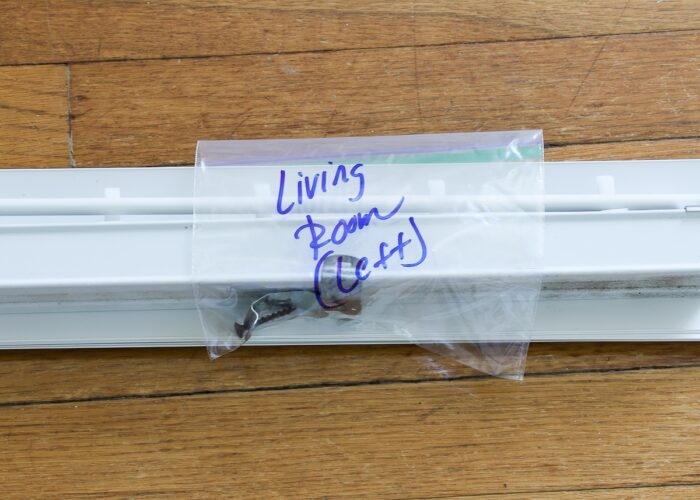
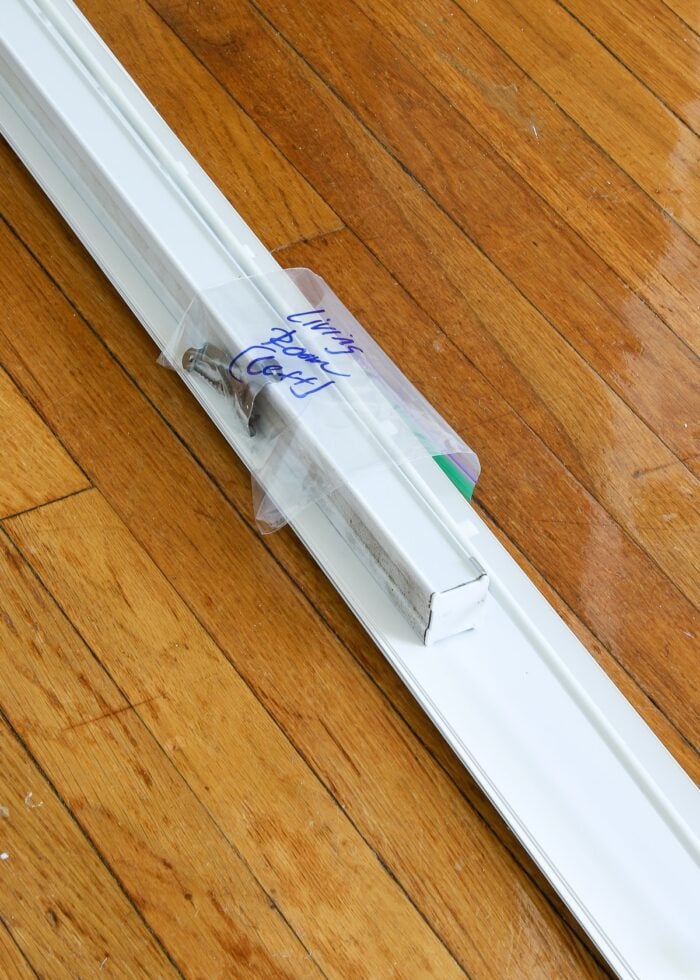
What To Put Up Instead
Okay, your vertical blinds are down – HOORAY! But now you’re windows are bare – BOO! Here are some other window treatments you can install instead!
Shades or Blinds
I realize taking down blinds to put up new blinds might feel a little silly. However, you can dramatically improve both the light control and style by installing something horizontal (rather than vertical).
Traditional roller shades, woven blinds, fabric blinds, wooden blinds, and even roman shades will look and function far better than vertical blinds, and are even now available in lots of affordable options for both inside mount and outside mount.
Curtains
Whether you need your windows covered or not, I always advocate hanging curtains. They add texture and softness that other home decor accessories simply cannot, and can majorly improve the aesthetic of windows that are awkwardly placed, oddly shaped, or lacking decorative moulding.
How to Hang Curtains On Rings With Perfect Results
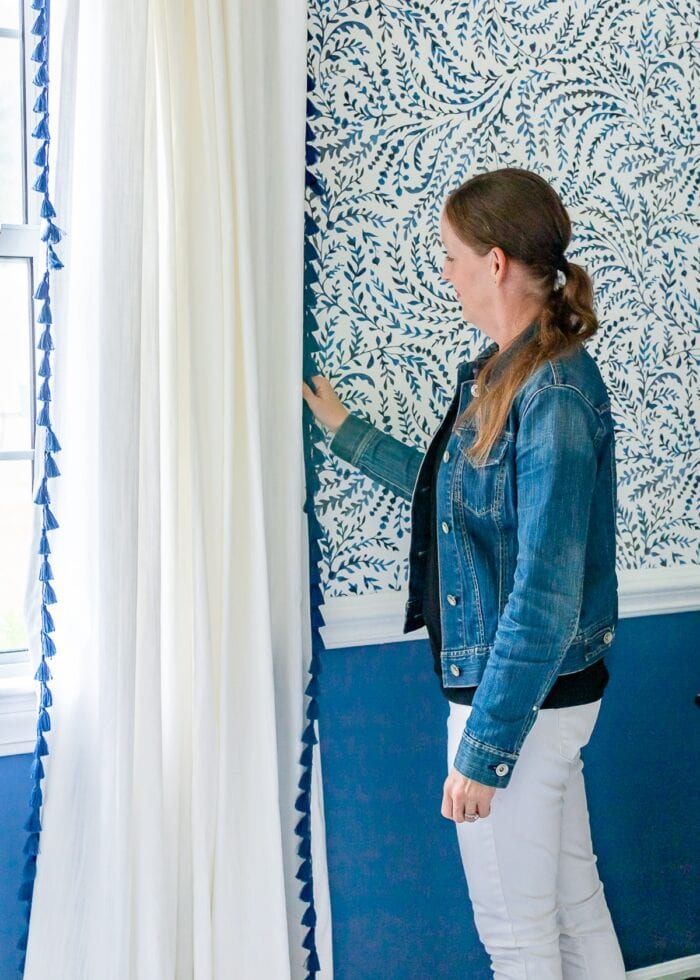
Cornice or Valance
Both cornices and valences cover only the top portion of a window, so they are purely decorative choices (they provide zero privacy or light blocking functionality).
Like curtains, they can be paired with horizontal blinds and shades; and having used cornices in several homes, I find they look best when you have moulding around the windows.
How to Make a Window Valance from Foam Insulation
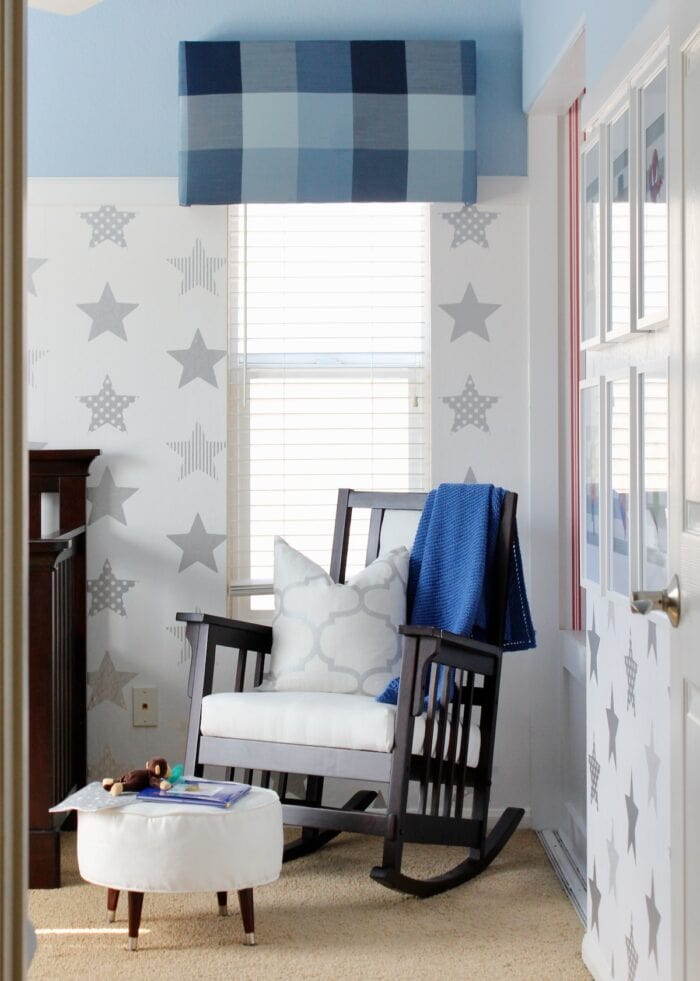
Nothing!
If you have nice moulding or trim around your windows AND you don’t need them covered for privacy or light-blocking, there’s nothing saying you need something on your windows. (Although, I’d argue curtains always look better than nothing at all! 😉)
Making the Case for Hanging Curtains In Your Rental
Other Great Window DIYs To Try
Looking for other great solutions for your windows? I've got you covered with these other smart DIYs!
- How to Make a Window Valance with Foam Insulation
- How to Sew a Window Valance
- How to Make a Window Valance with Foam Core Board & Wallpaper
- DIY Modern Wood Valance
- DIY Cornice Box with Scalloped Edges
- How to Hem Curtains | A Foolproof Method!
- How to Hem Curtains Without Sewing
- How to Widen Store Bought Curtains | An Easy Fix!
- How to Remove Vertical Blinds
- How to Install Your Own Blinds or Shades
- How to Hang a Curtain Rod Without Drilling into the Wall
- How to Hang Curtains On Rings (With Perfect Results!)
- How to Hang Curtains In a Corner Window
- 6 Easy DIY Window Valance Ideas (You Can Totally Make In an Afternoon)
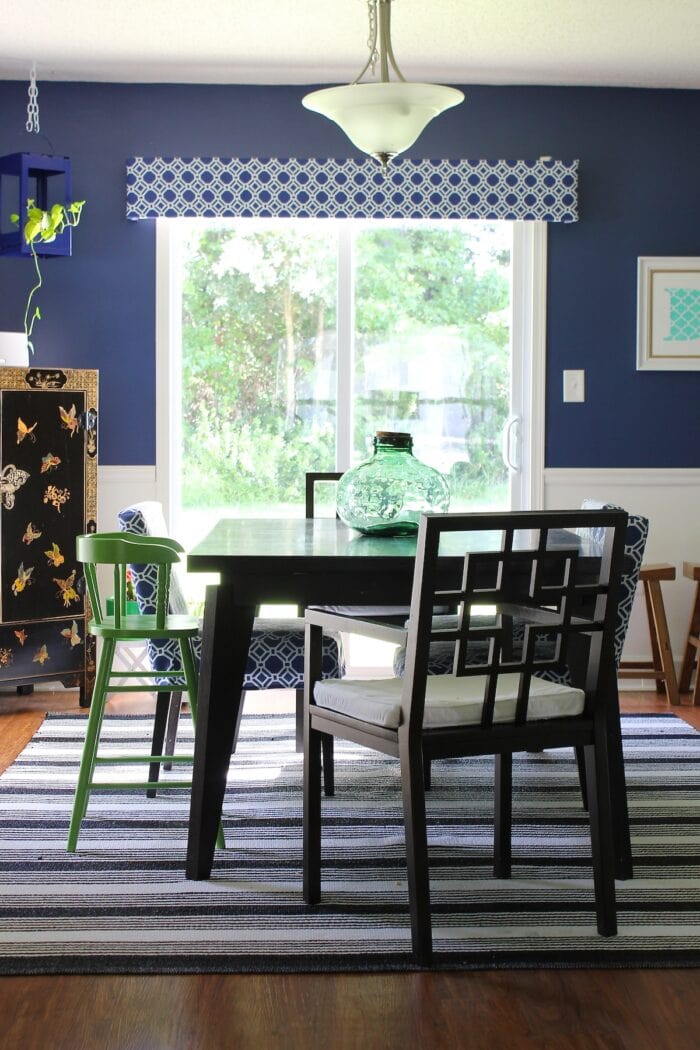
Okay – so what are you waiting for?!? Go take down those ugly, broken vertical blinds; then wrap them up and store them safely. Taking them down will only take you a few minutes (seriously!). Then you can pick out and install a window alternative that serves you and your home better!
Megan


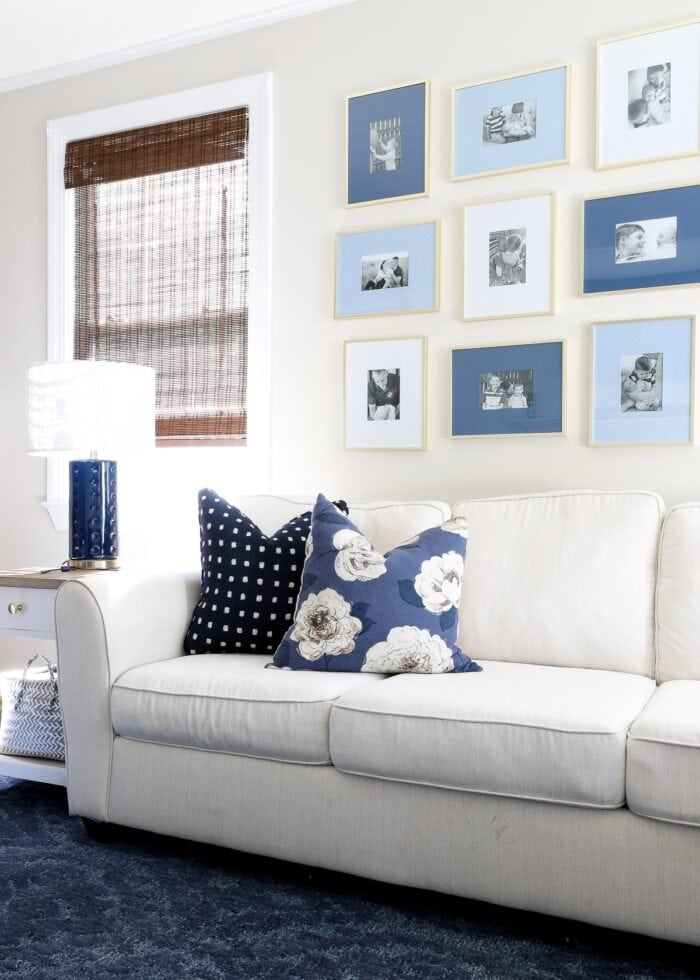
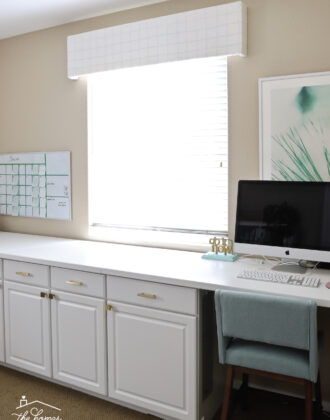

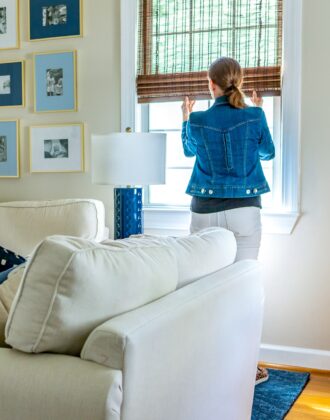
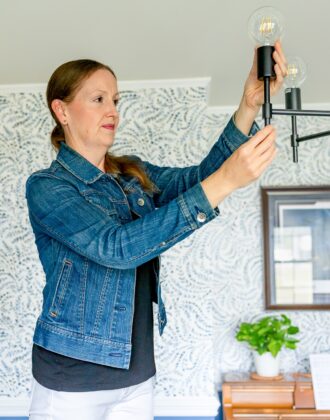

2 Comments on “How to Remove Vertical Blinds | It’s Easier Than You Think”
Every time I read one of your posts about windows, I keep thinking I need to hang curtains up! We have been in our home for a long, long time (I read your blog for the easy decorating ideas and I like your style), and we just have wood blinds up on the windows. We took down the 1970s dated options that were in our house when we moved in. I think this year may be the year I finally put something up to soften the look around here – especially my daughter’s room 🙂
Thanks for chiming in here, Nicole!
It’s so funny, I am in the opposite boat right now!
I almost always hang curtains. But in this house, we have nice wood trim around all our windows and I’m enjoying the cleaner display. So far we’ve only hung curtains in the dining room and kitchen, but I have the ones ready for our bedroom too!
They sure can be a pain to hang, but are oh so worth it! I hope you give it a try in your daughter’s room!
Megan